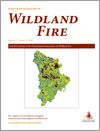International Journal of Wildland Fire
Volume 27
Number 9 2018
Interagency Hotshot Crews (IHC) travel substantial distances in the United States to respond to wildland fires, exposing the crewmembers to hazards from travel and fatigue. This research used historical IHC assignments to examine how dispatching policies might affect travel distances. The results indicate that the dispatching of IHCs could be achieved with less seasonal travel while mitigating for accumulated fatigue.
We compared Landsat-based estimates of fire-induced basal area mortality with multitemporal LiDAR only and LiDAR and Landsat combined models. LiDAR-only and combined models improved accuracy, reduced model bias and reduced prediction errors, offering an alternative method to quantify fire severity on specific ecological resources of interest.
Rainstorms that can generate debris flows in recently burned areas may occur during or immediately after the wildfire, leaving very little time for risk mitigation. We present a method for estimating post-fire debris-flow hazards prior to wildfire that could be used to prioritize areas in need of risk reduction efforts to reduce the potential impact of debris flows on communities.
Fuel hazard is widely thought to increase with time; however, there are few studies on fuel hazard in long-unburned forests. We measured overall fuel hazard in sites 0.5–>96 years since fire. Long-unburned forests supported overall fuel hazard that was equal to, or lower than sites burned within 0.5–2 years.
Burning of Acacia in sem-arid Western Australia promoted a small number of species not found on adjacent unburnt areas. Species richness in both burnt and unburnt areas increased in the absence of further fire and in association with large rainfall events. Periods of high rainfall increase biomass accumulation and increase the risk of fire, which is likely to reduce the effectiveness of chained and burnt buffers.
Using a theoretical approach based on the similitude theory, the ratio between the ROS and the wind speed has been expressed as a function of the fuel moisture content and the ratio between the two forces governing the behaviour of the flame front, i.e. the buoyancy and the inertia force of the wind.




